
The Indus is a transboundary river of Asia and a trans-Himalayan river of South and Central Asia. The 3,120 km (1,940 mi) river rises in mountain springs northeast of Mount Kailash in Western Tibet, flows northwest through the disputed region of Kashmir, bends sharply to the left after the Nanga Parbat massif, and flows south-by-southwest through Pakistan, before emptying into the Arabian Sea near the port city of Karachi.
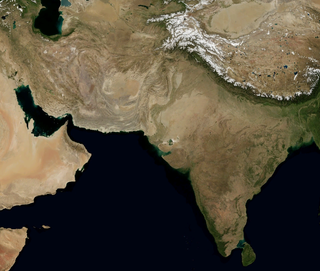
The Geography of Pakistan encompasses a wide variety of landscapes varying from plains to deserts, forests, and plateaus ranging from the coastal areas of the Indian Ocean in the south to the mountains of the Karakoram, Hindukush, Himalayas ranges in the north. Pakistan geologically overlaps both with the Indian and the Eurasian tectonic plates where its Sindh and Punjab provinces lie on the north-western corner of the Indian plate while Balochistan and most of Khyber Pakhtunkhwa lie within the Eurasian plate which mainly comprises the Iranian Plateau.

The Border Security Force (BSF) is the Border Service branch of the Central Armed Police Force. It is a paramilitary responsible for guarding the border, particularly India’s borders with Pakistan and Bangladesh. It is under the command of the Ministry of Home Affairs and was formed in the wake of the Indo-Pakistani War of 1965 for ensuring the security of the borders of India and for connected matters therewith.
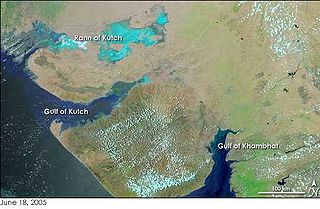
The Great Rann of Kutch is a salt marsh in the Thar Desert in the Kutch District of Gujarat, India. It is about 7500 km2 in area and is reputed to be one of the largest salt deserts in the world. This area has been inhabited by the Kutchi people.

In geography, hydrography, and fluvial geomorphology, a thalweg or talweg is the line or curve of lowest elevation within a valley or watercourse. Its vertical position in maps is the nadir in the stream profile.

The Sutlej River is the longest of the five rivers that flow through the historic crossroads region of Punjab in northern India and Pakistan. The Sutlej River is also known as Satadru. It is the easternmost tributary of the Indus River. The Bhakra Dam is built around the river Sutlej to provide irrigation and other facilities to the states of Punjab, Rajasthan and Haryana.

The Atlantique incident occurred on 10 August 1999, when a Breguet Atlantic maritime patrol aircraft of the Pakistan Naval Air Arm was shot down by a MiG-21 fighter of the Indian Air Force over the Rann of Kutch, on the border between India and Pakistan. Sixteen Pakistani personnel including the pilots were killed as a result. The episode took place just a month after the Kargil War ended, aggravating already tense relations between the two countries.

Lakhpat is a town in Kachchh district in the Indian state of Gujarat located at the mouth of the Kori Creek. The town is enclosed by 7km-long, 18th century fort walls.
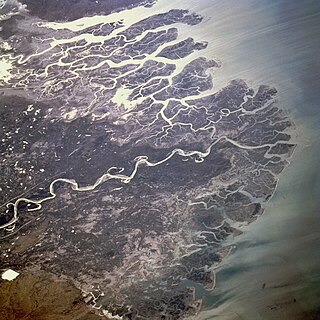
The Indus River Delta forms where the Indus River flows into the Arabian Sea, mostly in the southern Sindh province of Pakistan with a small portion in the Kutch Region of India. The delta covers an area of about 41,440 km2 (16,000 sq mi), and is approximately 210 km (130 mi) across where it meets the sea. The active part of the delta is 6,000 km2 in area (2,300 sq mi). The climate is arid, the region only receives between 25 and 50 centimetres of rainfall in a normal year. The delta is home to the largest arid mangrove forests in the world, as well as many birds, fish and the Indus dolphin.
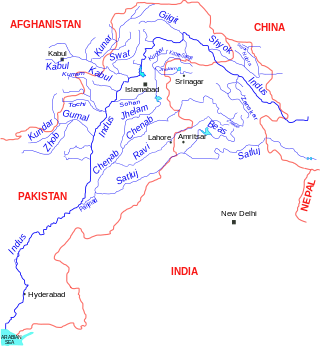
The Indus Water Treaty (IWT) is a water-distribution treaty between India and Pakistan, arranged and negotiated by the World Bank, to use the water available in the Indus River and its tributaries. It was signed in Karachi on 19 September 1960 by then Indian Prime Minister Jawaharlal Nehru and then Pakistani president Field Marshal Ayub Khan.

The India–Pakistan, Indo–Pakistani or Pakistani-Indian border is the international boundary that separates the nations of the Republic of India and the Islamic Republic of Pakistan. At its northern end is the Line of Control, which separates Indian-administered Kashmir from Pakistani-administered Kashmir; and at its southern end is Sir Creek, a tidal estuary in the Rann of Kutch between the Indian state of Gujarat and the Pakistani province of Sindh.

The Kori Creek is a tidal creek in the Kutch region of the Indian state of Gujarat. It lies just to the west of the Great Rann of Kutch area of India. This region belonging to India is a part of the Indus River Delta, which lies across Gujarat state in India and Sindh in Pakistan.

India–Pakistan maritime trespassing refers to the frequent trespassing and violation of respective national territorial waters of India and Pakistan in peacetime. Most trespassing is common to Pakistani and Indian fishermen operating along the coastline of the Indian state of Gujarat and the Pakistani province of Sindh. Recently the Indian Coast Guard apprehended a Pakistani fishing boat along the Gujarat coast and arrested 14 fishermen of the neighbouring nation. Most violations occur due to the absence of a physical boundary and lack of navigational tools for small fishermen. Hundreds of fishermen are arrested by the Coast Guards of both nations, but obtaining their release is difficult and long-winded owing to the hostile relations between the two nations.

The Rann of Kutch is a large area of salt marshes that span the border between India and Pakistan. It is located mostly in the Kutch district of the Indian state of Gujarat, with a minor portion extending into the Sindh province of Pakistan. It is divided into the Great Rann and Little Rann. It used to be a part of the Arabian Sea, but it then dried up, leaving behind the salt, which formed the Rann of Kutch. The Luni flowed into the Rann of Kutch, but when the Rann dried up, the Luni was left behind, which explains why the Luni does not flow into the Arabian Sea today.

There are several disputed territories of India. A territorial dispute is a disagreement over the possession or control of land between two or more states or over the possession or control of land by a new state and occupying power after it has conquered the land from a former state no longer currently recognized by the new state.

Ranchordas Pagi (1901–2013) worked as a scout on behalf of the Indian Army. His story is featured in a 2021 film Bhuj: The Pride of India where his character of an Indian Army Scout and R&AW agent is played by Sanjay Dutt.
Shakoor Lake is a lake, comprising 300 km2, located on the border between the Indian state of Gujarat and the Sindh province on the southern edge of Pakistan. About 90 km2 of the lake lies within Pakistan, whilst the majority of the lake, i.e. 210 km2, is in India. The Indian built Indo-Pak Border Road runs across the Shakoor Lake and it is joined by the Indian GJ SH 45 State Highway just east of the lake, at the Kanjarkot Fort.

The 2014–2015 India–Pakistan border skirmishes were a series of armed clashes and exchanges of gunfire between the Indian Border Security Force and the Pakistan Rangers: the paramilitary gendarmerie forces of both nations, responsible for patrolling the India-Pakistan border) along the Line of Control (LoC) in the disputed Kashmir region and the borders of the Punjab. Tensions began in mid-July 2014, with both countries' military officials and media reports giving different accounts of the incidents and accusing each other of initiating the hostilities. The incident sparked outrage in both countries and harsh reactions by the Indian and Pakistani militaries and the Indian and Pakistani governments.
Left Bank Outfall Drain is a drainage canal in Pakistan. Built between 1987 and 1997 using funding from the World Bank, the canal collects saline water, industrial effluents and Indus river basin floodwater from more than two million hectares of land of Shaheed Benazirabad, Sanghar, Mirpurkhas and Badin districts located in Nara River basin into the Arabian Sea.
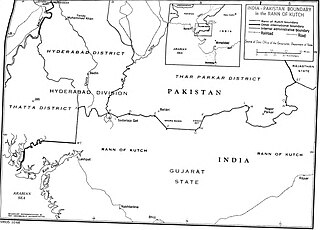
Operation Desert Hawk was the codename of a military operation planned and executed by the Pakistan Army in the Rann of Kutch area, the disputed area which was under Indian control from the long-standing status quo. The boundary of Rann of Kutch was one of the few un-demarcated boundaries pending since the 1947 partition of India.




















